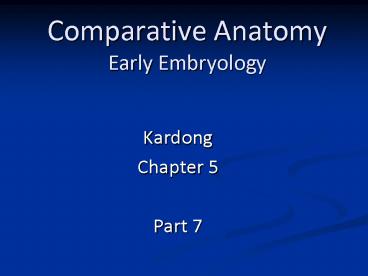Comparative Anatomy Early Embryology - PowerPoint PPT Presentation
1 / 21
Title:
Comparative Anatomy Early Embryology
Description:
Comparative Anatomy Early Embryo Author: Jennifer Leslie Knod Last modified by: strauth Created Date: 11/14/2005 4:51:39 AM Document presentation format: – PowerPoint PPT presentation
Number of Views:475
Avg rating:3.0/5.0
Title: Comparative Anatomy Early Embryology
1
Comparative AnatomyEarly Embryology
- Kardong
- Chapter 5
- Part 7
2
Vertebrate Egg
Figure 7.1. Cledoic egg.
- Amniotic egg- amnion present
- Reptilian egg- possesses shell(cleidoic)
3
Egg Type
- Microlecithal egg- small amount of yolk
- Mammals
- Mesolecithal egg- moderate amount of yolk
- Amphibians
- Macrolecithal egg- large amounts of yolk
- Reptiles, birds, sharks
4
Types of Cleavage
- Holoblastic- division into two equal sized cells
(e.g., in mammals) - Meroblastic- restricted to periphery, usually in
embryos with large amounts of yolk. Meroblastic
discoidal - Blastodiscs occur in some fishes,
reptiles, birds, and monotremes
Figure 7.2. Blastodisc.
5
Amphibian Embryogenesis
Figure 7.3. Frog development stages of
embryogenesis (book fig. 5-12)
6
Cleavage Stages
Figure 7.4.
Initial fertilized egg with fertilization
membrane (arrows)
2 cell stage 1st cleavage
4 cell stage 4 blastomeres
8 cell stage micromeres and macromeres 16 cell
stage (not shown)
64 cell stage blastula with blastocoel cavity
32 cell stage morula
7
Cleavage Stages (contd.)
Figure 7.5.
- Cells push inward to form gastrula
- Eventually eliminates blastocoel
8
Gastrulation
Figure 7.6. Gastrulation.
- Archenteron- primitive gut
- Blastopore
- Gives rise to anus in deuterostomes
- Gives rise to mouth in protostomes
- 3 primary germ layers
Figure 7.7. Cross section of frog gastrula.
9
Figure 7.8. Early frog gastrula.
- Dorsal lip - invagination of cells
- Move around yolk cells
- Yolk plug
- Notochord forms from mesodermal cells
10
Neurulation
- Neural plate thickens and pushed inward
- Neurectoderm- gives rise to nerve tube
- Neural crest cells- between nerve tube and
ectoderm - Dorsal root ganglion, branchial cartilages cells,
and pigment cells - Anterior cells- dermis of face, cephalic armor,
sensory capsules
Figure 7.9. Embryonic neurulation.
11
Figure 7.10. Neural crest cell differentiation.
(Table 5.2 page 189).
12
Dorsal Mesoderm
Figure 7.11.
- Dermatome- associated with ectoderm
- Dermis in most of body
- Myotome
- Skeletal muscle
- Sclerotone- associated with nerve tube
- Skeletal and vertebral column
13
- Dorsal mesoderm (somite) splits to form coelom
cavity - Somatic mesoderm - bound to ectoderm
- Splanchnic mesoderm- bound to endoderm
- Somatopleure - somatic mesoderm meets ectoderm
- Splanchnopleure - splanchnic mesoderm meets
ectoderm
Figure 7.12. Mesoderm specialization (book Fig.
5.6).
14
Dorsal Mesoderm Differentiation
Figure 7.13.
- Dorsal mesoderm (somite)- Epimeric mesoderm
- Intermediate mesoderm- Mesomeric mesoderm
- Lateral plate mesoderm- Hypomeric mesoderm
15
Primary Germ Layers
Figure 7.14. Formation of the three primary germ
layers.
16
Germ Layers (contd.)
Figure 7.15. Organs derived from the germ
layers.
17
Structures formed from the three germ layers.
Figure 7.16.
18
Ectodermal placodes in a representative
vertebrate.
Figure 7.17.
19
Extraembryonic Membranes
Figure 7.18. Extraembryonic membranes of cledoic
egg.
20
Extraembryonic Membrane Formation in a Bird
Figure 7.19. Extraembryonic membranes.
21
Principles of Embryology
Figure 7.20. Embryological development.































